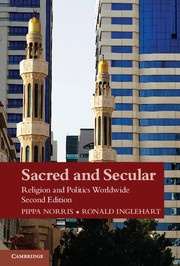Book contents
- Frontmatter
- Contents
- Tables
- Figures
- Preface and Acknowledgments
- Part I Understanding Secularization
- Part II Case Studies of Religion and Politics
- Part III The Consequences of Secularization
- 7 Religion, the Protestant Ethic, and Moral Values
- 8 Religious Organizations and Social Capital
- 9 Religious Parties and Electoral Behavior
- Conclusions
- Appendix A
- Appendix B
- Appendix C
- Notes
- Bibliography
- Index
9 - Religious Parties and Electoral Behavior
from Part III - The Consequences of Secularization
Published online by Cambridge University Press: 05 June 2012
- Frontmatter
- Contents
- Tables
- Figures
- Preface and Acknowledgments
- Part I Understanding Secularization
- Part II Case Studies of Religion and Politics
- Part III The Consequences of Secularization
- 7 Religion, the Protestant Ethic, and Moral Values
- 8 Religious Organizations and Social Capital
- 9 Religious Parties and Electoral Behavior
- Conclusions
- Appendix A
- Appendix B
- Appendix C
- Notes
- Bibliography
- Index
Summary
throughout the christian world, popes, cardinals, and clergy once exercised immense political influence, sometimes bending kings and emperors to their will. They have lost this preeminent political role in modern Western democracies. Church leaders continue to take positions on controversial moral and social issues, ranging from gay marriages, the availability of divorce and abortion rights, to questions of war and peace – but today, they are only one voice among many. Similarly, the once dominant function of the Church in education, healthcare, and alleviating poverty has been transformed by the emergence of the welfare state, so that even where faith-based organizations continue to offer these services, they are state-regulated and authorized by professional bodies. The role of religious symbols, rituals, and rhetoric has been reduced or abandoned both in public life and in the arts, philosophy, and literature. There is no question that the relationship between church and state has changed dramatically. Nevertheless, religion continues to have a major impact on politics. The rise of radical Islamic parties, and the consequence of this development for political stability in the Middle East, North Africa, and Asia, has revived popular interest in this phenomenon.
This chapter examines the impact of secularization on partisan support and voting behavior in the mass electorate. Religious dealignment, the evidence suggests, has diluted traditional loyalties linking Catholic voters and Christian Democratic parties in postindustrial nations. But has the process of secularization in postindustrial societies actually eroded the extent to which people vote along religious lines? Here, religion still seems to play a powerful role. In the 2000 U.S. presidential election, for example, religion was by far the strongest predictor of who voted for Bush and who voted for Gore – dwarfing the explanatory power of social class, occupation, or region. There was a stark difference in the 2000 election between “traditionalists” – middle-aged married voters with children living in the rural South and Midwest who came from a religious background, supporting Republican George W. Bush, and the “modernists” – including single college-educated professionals living in urban cities on both coasts, who rarely attended church, and who voted for Democrat Al Gore. What are the common linkages between religion and support for given political parties elsewhere? And how does this relationship vary between industrial and agrarian societies?
- Type
- Chapter
- Information
- Sacred and SecularReligion and Politics Worldwide, pp. 196 - 212Publisher: Cambridge University PressPrint publication year: 2011

